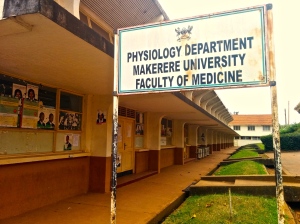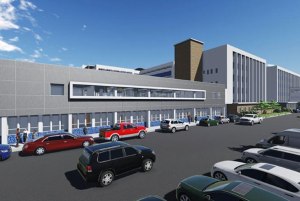
Ask any Ugandan on the streets of Kampala how to get to Mulago Hospital, and you will get an enthusiastic response to your inquiry. Faces lighten up with curiosity, “Are you a nurse? A doctor? Ahh, good.” The place and name is as important a part of the city as its churches, mosques, markets, and historic landmarks. At one time or another, it has served all of those buildings’ purposes, too.

Mulago Hospital is a sprawling establishment in northern Kampala, bearing witness to almost 100 years of history and symbolizing the evolution of Ugandan health. Known quickly as “Mulago,” the Mulago National Referral Hospital was founded in 1917 by Albert Ruskin Cook, a British mission doctor and revered as the “founder of modern Ugandan medicine” [1]. In 1962, the original Mulago site was replaced with a collection of smaller buildings now called Old Mulago. As of the summer of 2015, Mulago’s activity is split between the Old Mulago buildings from its 1962 construction and half of the massive complex under construction as of 2012, the New Mulago. With a 1790 bed capacity, Old and New Mulago are housing 3000+ inpatients and between 6000 to 7000 outpatients daily [2]. It’s next to impossible to wrap your head around such massive patient volumes until you see the wards in person. Most beds are full, or waiting to be taken. Patients and their family members bring mats for the floor, while the outside corridors, courtyards, and benches are occupied day and night.
 It is the oldest, and largest, of Uganda’s three referral hospitals (the others being Butabika and Mbarara). Today, it offers services under a wide variety of specialists and affiliated institutes: surgery, internal medicine, cardiology, infectious disease, pediatrics, obstetrics and gynecology, oncology, radiology, neurology, endocrinology, rheumatology, ICU, renal dialysis, dentistry and oral surgery, orthopedics, otolaryngology, dermatology, sexual health, urology, accident and emergency medicine, physiotherapy, and pharmacologic services. These are the ones I have been able to record during my rounds, but I’m sure there are more.
It is the oldest, and largest, of Uganda’s three referral hospitals (the others being Butabika and Mbarara). Today, it offers services under a wide variety of specialists and affiliated institutes: surgery, internal medicine, cardiology, infectious disease, pediatrics, obstetrics and gynecology, oncology, radiology, neurology, endocrinology, rheumatology, ICU, renal dialysis, dentistry and oral surgery, orthopedics, otolaryngology, dermatology, sexual health, urology, accident and emergency medicine, physiotherapy, and pharmacologic services. These are the ones I have been able to record during my rounds, but I’m sure there are more.

Affiliated with the Makerere University College of Health Sciences, which also has its campus on Mulago premises, the hospital is quickly becoming the Ugandan (and African) centre for clinical and research innovation. Any Google search can provide publications and international collaborations based from and at Mulago. Government and foreign investments maintain Mulago as a public hospital, available through referrals from clinics and hospitals throughout Uganda or direct access for those most in need of its services (more to come on the Ugandan healthcare system next week, when I’ll attempt to describe it as accurately as possible). Despite seemingly constant shortages in staff (many Ugandan doctors left in the 1970s during Idi Amin’s rule) and supplies (patients are expected to bring many resources, from gloves to surgical blades), Mulago remains a testament to the ingenuity and loyalty of its people.

Weighing the struggles Mulago faces daily to keep its doors open, it truly is an inspiring institution. Positive collaborations with influential international collaborators and the enthusiasm of the Ugandan medical and academic community will likely sustain Mulago and contribute to its growing strength. Staring down the courtyard at the hundreds of Ugandans awaiting their brief but highly anticipated interaction with the healthcare system, I cannot help but feel small. My presence here is so insignificant, unhelpful to any of these people waiting so patiently and desperately for care. The knowledge of these physicians, nurses, midwives, and all other staff could fill thousands of libraries, yet the resources they need to carry out their patient management plans couldn’t even fill their hospital. How they carry on will be my most important, and humbling, medical lesson yet.

Resources:
[1] Mulago.or.ug. Mulago | Uganda National Referral Hospital [Internet]. 2015 [cited 25 July 2015]. Available from: http://mulago.or.ug/
[2] Ayebazibwe A. Mulago hospital renovation starts [Internet]. The Saturday Monitor. 2014 [cited 25 July 2015]. Available from: http://www.monitor.co.ug/News/National/Mulago-hospital-renovation-starts/-/688334/2481588/-/item/1/-/13ye8mb/-/index.html.
[3] Obore C. Time bomb: The inside story of Mulago hospital’s troubles [Internet]. The Saturday Monitor. 2013 [cited 25 July 2015]. Available from: http://www.monitor.co.ug/News/National/Time-bomb–The-inside-story-of-Mulago-hospital-s-troubles/-/688334/1669688/-/13xumh5/-/index.html.